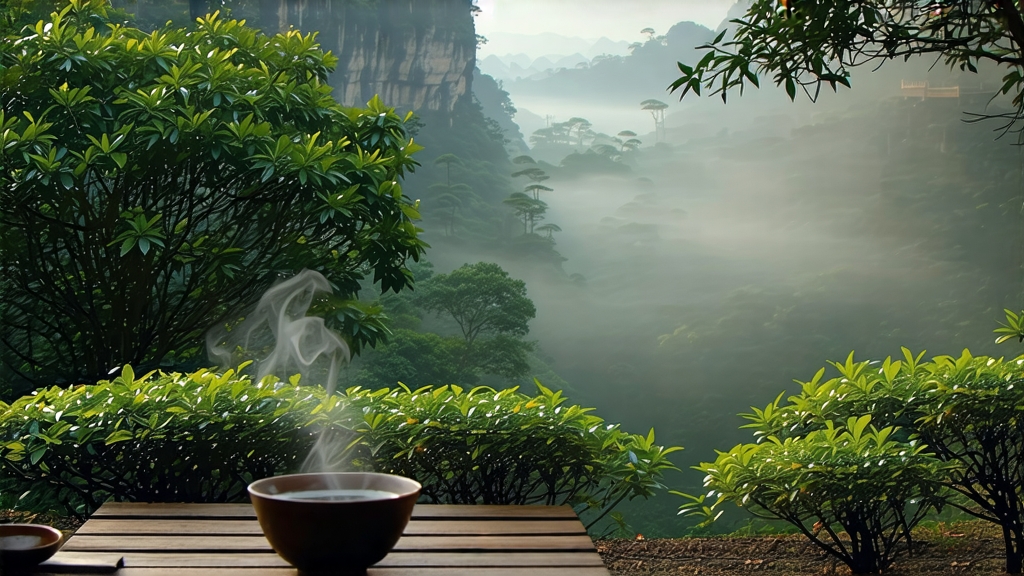
High in the mist-curtained Wuyi Mountains of northern Fujian, where the Nine-Bend River coils like a jade ribbon around towering red sandstone cliffs, grows the most mythologized oolong on earth—Da Hong Pao, literally “Big Red Robe.” To Chinese tea lovers those three syllables carry the weight of imperial history, poetic romance, and almost alchemical mastery. Internationally the name is often slapped on pedestrian blends, yet the authentic leaf remains a sensory time-machine: one sip can still summon the scent of monastery pine smoke, the taste of mineral-rich cliff water, and the hush of Song-dynasty scholars who once climbed these same stone stairs to sip tea with Taoist monks.
Origin stories vary, but the most beloved dates to the Ming dynasty. A Ming emperor’s mother fell gravely ill; monks from the Wuyi Tianxin Temple presented a tea plucked from six ancient bushes clinging to a narrow ledge called Jiulong Ke—“Nine-Dragon Nest.” The empress recovered, and in gratitude the emperor sent crimson silk robes to drape the bushes, declaring them sacred. Whether apocryphal or not, those six mother trees, now protected by UNESCO and never harvested, still stand as living monuments, their gnarled trunks like calligraphy brushed against the rock.
Genetic tests confirm that Da Hong Pao belongs to the Wuyi qizhong—“strange cultivar”—family, a diverse group of indigenous bushes evolved in mineral-heavy soil. Over centuries farmers selected the most aromatic individuals, giving rise to named clones such as Bei Dou #1, Que She (“Sparrow Tongue”), and the floral Qi Dan. Today authentic Da Hong Pao is crafted in three tiers: mother-tree cuttings grown in the original 1 km² core scenic reserve (zhengyan), bushes on nearby slopes (banyan), and high-elevation gardens outside the park (zhoucha). Each terroir layer imparts a different intensity of yan yun—“rock rhyme”—the elusive limestone-mineral note that lingers like a struck bell.
Harvest begins in late April when the standard “open-face” leaf is reached: three leaves and a bud angled like a phoenix tail. Pickers climb bamboo scaffolding lashed to the cliff, filling small wicker baskets that prevent bruising. The leaves are then carried to the village of Yanzhen where they undergo the most labor-intensive oolong craft in China.
Withering starts outdoors on water-woven bamboo racks set into the cliff-side courtyards. Morning mist dehydrates the surface while the stem remains turgid, a state called “soft bone.” At noon the leaf is gently shaken in rattan tumblers, edge bruising that initiates oxidation. A master monitors the scent shift from cut grass to ripe peach, deciding the exact moment to kill-green in a 200 °C drum roaster. Rolling follows, but unlike Tie Guan Yin’s tight ball style, Da Hong Pao is strip-twisted, preserving the cellular channels that will later conduct heat during charcoal roasting.
Roasting is the soul of Wuyi craft. Traditionally it happens in a squat clay kiln fueled by local lychee-wood charcoal that burns at a steady 80 °C. The tea sits on wire screens stacked seven layers high; every forty minutes the master lifts each tray, sifts the leaf, and listens to the rustle—when the sound turns from moist whisper to dry rustle he knows the moisture gradient is narrowing. Three rounds over six weeks reduce the water content to 3 % while pyrolyzing sugars into caramel, lignin into incense, and amino acids into roasted chestnut. Done correctly the leaf emerges obsidian-black with a faint gunmetal sheen; over-roast and the coveted floral top notes are lost forever.
Aging potential is another hallmark. Like fine Burgundy, well-roasted Da Hong Pao softens and deepens for decades if stored in unglazed clay jars breathing the coastal air of Fujian. Connoisseurs speak of 30-year cakes that brew the color of sherry and taste of dried longan, wet slate, and temple sandalwood.
To brew Da Hong Pao gongfu style you need a 120 ml gaiwan or small Yixing teapot, preferably seasoned with only rock oolongs. Pre-heat every vessel with boiling water; the clay should be too hot to touch, locking in temperature during the flash infusions. Use 5 g